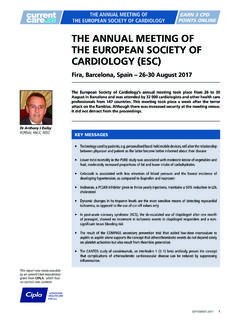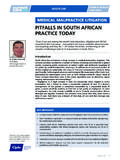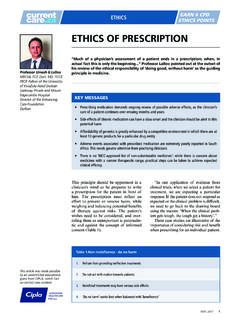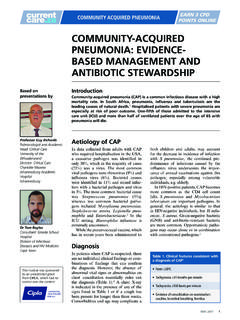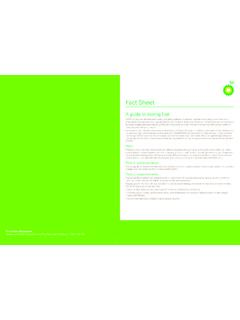Transcription of Presented by Clinical picture of menopause
1 NOVEMBER 2021 I 1 Leader in digital CPD for Southern African healthcare professionalsWomen s healthEarn 2 free CEUs 2021 deNovo MedicaMA-ANG_ZA-0002-1 Presented byDr Trudy SmithGynaecologist Donald Gordon Medical CentreJohannesburgCase studyClinical picture of menopauseCase study reflecting hormone replacement therapy in the 21st centuryThis case study reflects Clinical issues in a patient s experience of hormonal change that result in a series of visits to her healthcare objectivesYou will learn: Factors that contribute to a symptomatic menopause transition The benefits and risks of different contraception methods during perimenopause Management of the genitourinary syndrome of menopause Special considerations for women with HIV and breast cancer survivors who are going through case report was sponsored by Bayer.
2 The content of the report is independent of the sponsor. The expert participated voluntarily. shutterstock/13955587102 I NOVEMBER 2021 Case study: Clinicial picture of menopauseClinical questions1. Which blood tests would you do?A. FSH/E2 thyroid functionsB. FBC/U and EC. HBA1C and FBCD. Fasting glucose and FBC Expert comment BMI and race impact hormones. Obesity is associated with lower LH, FSH, oestradiol and progesterone secretion, as well as marked decreases in urinary hormone metabolite excretion. Obese women experience a lower rise in FSH and a less steep decline in oestradiol as they traverse into the menopause . Women who have variable hormone levels over time are also more likely to have a symptomatic transition.
3 Hyperthyroidism is a common cause of hot information Mrs MM is a 47-year-old; parity 2 gravidity 2 Complaining that she is unable to sleep at night and has severe hot flushes She has hot flushes during the day they occur particularly shortly before her menstrual history Her last menstrual period was two weeks prior They have occasionally been seven days late. Habits and lifestyle Non-smoker Moderate drinker Divorced and currently in a new relationship. History No past medical history No hypertension/diabetes and not on any medication Two previous caesarean sections. Family history Mother had breast cancer at 77 years of age Grandmother was a diabetic. Examination BMI 34kg/m2; BP 120/86mmHg No thyromegaly Breasts normal Abdomen soft, non-tender, no masses Per vaginal examination: uterus normal, adnexa revealed no is associated with lower LH, FSH, oestradiol and progesterone secretionNOVEMBER 2021 I 3 Case study: Clinicial picture of menopauseEARN FREECPD POINTSJoin our CPD community atand start to earn today!
4 Patient s FSH is 10IU and her oestradiol is 175 What would your best advice to the patient be?A. Lose weight B. Wear layered clothingC. Exercise D. All of the aboveExpert comment Obesity is associated with an increase in hot Hot flushes are mediated by thermoregulatory dysfunction at the level of the hypothalamus and are induced by oestrogen withdrawal. The thermoneutral zone is narrowed in women with hot Behavioural modification such as layered clothing, lowering the temperature of the room, and avoiding triggers such as alcohol, spicy food and stressful situations decrease hot The patient has entered a new relationship and is concerned about contraception. Your advice would be always to use a condom and:A.
5 No contraception required because her pregnancy risk is low B. She should use a combined oral contraceptive C. A Mirena is a good optionD. A Kyleena would be an option Expert comment The possibility of pregnancy in women aged 45-49 who are not using contraception is estimated to be 2-3%, and women cannot be assured of A low-dose oral contraceptive is an option in many women seeking relief of menopausal symptoms and who require contraception, either an oestradiol-containing contraceptive or a low-dose 10 or 20mcg ethinyl oestradiol-containing pill. However, these should be avoided in obese patients because they are at greater risk of thromboembolic disease. Other contraindications include smoking, hypertension and migraine with The Mirena is a good choice in an obese perimenopausal woman as it will provide endometrial protection together with contraception.
6 The addition of transdermal oestrogen in a low dose can give relief of hot The Kyleena does not give adequate endometrial protection if hormone replacement is consultation two years laterAfter two years of having the Mirena, Mrs MM, now 50 years old, visits your office. She did not use hormones because her friends told her that they cause cancer. Her flushing has recently worsened, she is not sleeping and her anxiety is through the roof. She has lost weight and her BMI is now 29kg/m2. She is concerned about her memory as her mother developed Alzheimer s disease at age 60 and remained in frail care for the rest of her Taking hormones:A. Will decrease cognitive functionB. Will improve cognitive functionC.
7 Is neutral on cognitionD. Only improves cognition when used late in menopause Expert comment Many women describe brain fog. When oestrogen hormone therapy (HT) was initiated in early menopausal women it appeared, in epidemiological studies, to improve and protect cognitive performance. Later use, however, appeared to decrease cognitive function. Oestrogen should not be used for the sole purpose of improving cognitive flushes are mediated by thermoregulatory dysfunction at the level of the hypothalamus and are induced by oestrogen withdrawal4 I NOVEMBER 2021 Case study: Clinicial picture of menopause5. Your treatment choice for Mrs MM s hot flushes is:A. Transdermal oestradiolB. Combined oestradiol and progestogen pillsC.
8 Oral oestradiolD. Vaginal oestradiolExpert comment Mrs MM has a Mirena in situ, which will provide endometrial protection for the next three years. She must be counselled that it is important to take both oestrogen and progesterone, because she may develop a uterine malignancy should she only be on oestrogen. Transdermal oestradiol in the lowest dose for symptom relief is preferred. Transdermal oestrogen comes in the form of a patch or gel. The use of transdermal preparations decreases thrombotic risk and has a positive effect on the lipid profile and the diabetic MM is afraid to take hormone treatment because her friends say she will get breast cancer. She would like to discuss The breast cancer risk is:A. Dependent on the type of hormone treatmentB.
9 Dose dependent C. Only associated with oestrogenD. Statistically significant Expert comment The use of HT is associated with both a decrease and increase in breast cancer. It varies by type, duration and if it is combined with a progestogen. There was, in fact, a decrease in breast cancer in the conjugated equine oestrogen CEE alone arm of the WHI trial. The combination of CEE and medroxyprogesterone was associated with an increase in breast cancer but, overall, this was not statistically significant. Large observational studies using oestradiol and varying progestogens showed that micronised progesterone was associated with no risk of breast much discussion, Mrs MM decided to use transdermal oestradiol with her consultationShe returns for a follow-up appointment, but is having a problem with intimacy.
10 Her vagina feels dry and she feels like she needs to pass urine all the With regard to genitourinary syndrome of menopause (GSM):A. Hormone replacement should be advantageous B. Vaginal oestrogen in addition to hormone replacement should be offeredC. Vaginal lubricants should be used D. Testosterone therapy should be introduced Expert comment GSM is the new term for vulvovaginal atrophy. It is characterised by lack of lubrication, discomfort during intercourse, urgency dysuria and recurrent urinary tract Oral and transdermal HT fails to treat vaginal symptoms in 10-15% of women and additional low-dose vaginal oestrogen is about Mrs MM s cardiovascular system were expressed during the consulta-tion as her father has had a heart attack and she is concerned that HT will cause a prob-lem.
